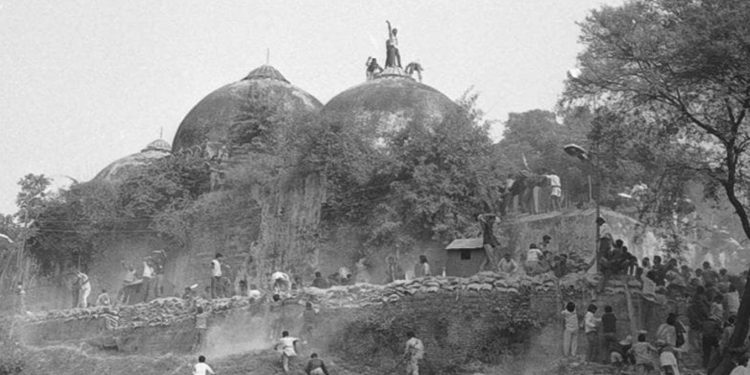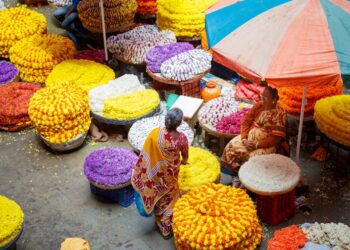In January 2024, the U.S.-based Hindu nationalist group, the Hindu American Foundation (HAF), released a series of videos and a so-called factsheet addressing the construction of the Ram Temple in Ayodhya which was built on the ruins of the 500-year-old Babri Masjid.
But a careful examination of historical records, religious texts, and legal judgments reveals HAF’s article to be fraught with lies, inaccuracies, deliberate fabrications, and questionable historical narratives.
Lie: The HAF writes that the new Ram temple was “built on an ancient site of Hindu worship. The final Hindu temple on the site was destroyed in the early 16th century by the first Mughal emperor for the construction of a mosque known in modern times as the Babri Masjid. Archaeological evidence proves the mosque had no foundations of its own and was built upon a Hindu temple.”
Truth: This is a brazen lie propagated by the Rashtriya Swayamsevak Sangh (RSS) with no historical or legal proof, nor any corroboration in the ‘Hindu’ narrative of history. There is no mention of the Ram Temple even in the writings of the most prominent Ram worshiper to date, Goswami Tulsidas (1511-1623), who penned the Epic Ramcharitmanas (Lake of the Deeds of Ram) in the Avadhi language in 1575-76. According to the Hindu nationalist (Hindutva) version, Ram’s birthplace temple was destroyed during 1528-1529. It would be surprising indeed if the Ramcharitmanas, written only 48 years after the so-called destruction of Ram’s birthplace temple, did not mention such a momentous event.
According to the RSS, Adi Shankaracharya, Aurobindo Ghosh, Swami Vivekananda, and Swami Dayanand Saraswati were the saints who contributed immensely to the cause of Vedic religion and the growth of the Hindu nation. None of these Vedic saints ever referred to this destruction of Ram Temple at Ayodhya by Mughal King Babar or his agent in any of their writings.
Today, Ayodhya is referred to as one of the oldest holiest places for Hindus. It would be interesting to know that Adi Shankaracharya (788-820), who toured India preaching Vedas for more than a decade, established 5 Peetams [main centers] at Badrinath in the North, Puri in the East, Dwarka in the West and Sringeri and Kanchi in the South for the revival of the Vedic religion but did not consider Ayodhya one.
Moreover, the Indian Supreme Court, in its 1,045-page Ayodhya Judgment (November 9, 2019), nowhere agrees with the claim that the Babri Mosque was constructed after destroying any temple.
Lie: HAF claimed that “As the traditional birthplace of Lord Ram, archeological and documentary evidence shows that the site has been recognized as a place of spiritual importance for Hindus since time immemorial.”
Truth: It is true that traditionally, Hindus believe that Ram was born in the city of Ayodhya, but the issue is whether he was born exactly under the central dome (approximately measuring 150 cm x 150 cm) of the Babri Mosque as is claimed now by Hindutva’s flag-bearers.
But here it is important to note that the Indian Supreme Court, in its 2019 judgment, made two observations on this point without mincing words.
Firstly, it stated: “The exclusion of the Muslims from worship and possession took place on the intervening night between 22/23 December 1949 when the mosque was desecrated by the installation of Hindu idols. The ouster of the Muslims on that occasion was not through any lawful authority but through an act which was calculated to deprive them of their place of worship.” [Supreme Court Judgment dated November 9, 2019, pp. 921-22]
Secondly, on pages 913-14, it states that “On 6 December 1992, the structure of the mosque was brought down and the mosque was destroyed. The destruction of the mosque took place in breach of the order of status quo and an assurance given to this Court. The destruction of the mosque and the obliteration of the Islamic structure was an egregious violation of the rule of law.”
It is worth mentioning here that RSS —which initiated the bloody, violent campaign to build the Ram Temple at the end of the 1980s, never advanced this demand during the period of its founding in 1925, under British rule. Even after Independence, it was only in 1989 that the political appendage of the RSS, the BJP, began to focus on this issue.
The views of two RSS luminaries who initiated the Ram Temple movement reveal the preposterousness of the claim that Ram himself was born under the dome.
Rama Vilas Vedanti, a prominent Hindu clergyman of the Ram Birthplace Trust (an RSS front), stated, “We will build a temple at Ramjanam Bhoomi even if Lord Rama says he was not born there” [Outlook, Delhi, 7 July 2003). Similarly, L. K. Advani, who rode a chariot (Rath Yatra) as part of an aggressive Ram Temple campaign in 1990 said, “It did not matter whether the historical Rama was actually born at the spot in Ayodhya. What mattered was that Hindus believed that he was born there. Faith took precedence over history” [The Hindustan Times, Delhi, 20 July 2003.]
The votaries building the Ram Temple at the place of Babri Mosque must also respond to the query of why only one temple was targeted by Babar and not hundreds of other Hindu temples in Ayodhya.
Lie: According to HAF, the construction of the Ram Temple at the site of the Babri Mosque was essential to seek “restorative justice to re-establish a Hindu temple that had been destroyed as a result of iconoclasm a few hundred years ago.” They allege that the Ram Mandir “has great symbolic and emotional resonance for Hindus in contemporary times” and that “the trauma that this destruction brought has been passed down through generations and continues to impact the psyche of Hindus” and “contributed historically and continues to contribute to Hindu-Muslim tensions in India to this day.”
It is nobody’s argument that Aurangzeb or many other ‘Muslim’ rulers were not religious bigots or tolerant. Aurangzeb did not spare his father, brothers, and many smaller ‘Muslim’ kingdoms of his times. There are also contemporary records that prove that Aurangzeb donated lands, money, and resources to many temples throughout India.
Truth: According to this logic, the rule by rulers with Muslim names in India was the Islamic rule of idol-breakers. This narrative of Muslim history developed only at the beginning of the 19th century is in absolute contradiction with historical facts and even common sense. To understand the lies behind this fabricated Medieval past, one needs to examine the nature of this ‘Muslim’ rule.
Despite the ‘Muslim’ rule of almost one thousand years, almost 75% of Indians did not convert to Islam, as was made clear by the first Census held by the British in 1871-72 when even ceremonial ‘Muslim’ rule was over. Hindus and Sikhs constituted 73.5 percent of the population, and Muslims numbered 21.5 percent only. Moreover, this rule was also the rule of the Hindu High Castes. According to contemporary ‘Hindu’ narratives, Aurangzeb never faced Shivaji in the battlefield; these were his two Rajput commanders, Jay Singh I and Jai Singh II, who fought against Shivaji on Aurangzeb’s behalf. Akbar personally never fought any battle against Rana Pratap of Mewar; Man Singh, brother-in-law of Akbar fought all battles against Rana. The Deewan Ala (prime minister) of both Shahjahan and Aurangzeb was Raghunath Bahadur, a Kayasth Hindu.
It is nobody’s argument that Aurangzeb or many other ‘Muslim’ rulers were not religious bigots or tolerant. Their religious bigotry was the outcome of their feeling of insecurity. Aurangzeb did not spare his father, brothers, and many smaller ‘Muslim’ kingdoms of his times. There are also contemporary records that prove that Aurangzeb donated lands, money, and resources to many temples throughout India. Anybody who has visited Delhi’s Red Fort must have seen two temples; Jain Lal Mandir [Red Temple] and Gauri Shanker Temple, just across the Fort towards Chandni Chowk side. These temples were built before the rule of Aurangzeb and continued to function during his time and later.
Lie: HAF, parroting the RSS claim, declared that the building of the Ram Temple was “an important event for Hindus of all traditions.”
Truth: HAF did not tell us why 4 Shankaracharyas of the Peetams (out of 5) established by Adi Shankaracharya boycotted the inauguration of the Ram Temple at Ayodhya. The article does not mention that the most revered Hindu saints of the Sanatan Dharm declared Ayodhya’s inauguration to be in contravention of Vedic scriptures, calling it Hinduism done for petty electoral gains.
It is sad to see the HAF run roughshod over the diversity of Hinduism. In its attempt to prove the homogenous character of Hindus, HAF turned a debate on the nature of the Ayodhya inauguration into Hindus versus others. The founder of Arya Samaj, Swami Dayanand Saraswati, is glorified by RSS as a pillar of the Hindu nation. But Swami was an ardent opponent of the Brahmanical ritual of Pran Pratishtha (putting life into a lifeless idol in Ayodhya case by Prime Minister Modi) and did not mince words in decrying this very ritual. He has stated (in Satyarth Prakash or Light of Truth, chapter 11), “The fact of the matter is that the All-pervading Spirit [God] can neither come into an idol, nor, leave it. If your mantras are efficacious that you can summon God, why can you not infuse life into your dead son by the force of the very same mantras? Again why can you not bide the soul depart from the body of your enemy? There is not a single verse in the Vedas to sanction the invocation of the Deity and vitalization of the idol, likewise, there is nothing to indicate that it is right to invoke idols, to bathe them, install them in temples, and apply sandal paste to them.”
HAF should enlighten us as to why a pious Hindu believing Ram to be God, Mahatma Gandhi, was assassinated by Hindutva cadres on January 30, 1948.
Lie: HAF also argued that, “Though sometimes presented as being a recent conflict, the fact is that this site has a long history of Hindus and Sikhs attempting to reclaim it, dating back to the early 19th century. Furthermore, the conflict has been ongoing regardless of the political party in power following India’s independence.”
Truth: Ayodhya being one of the holiest places, and the place under the central dome of the Babri Mosque, being the exact place where Ram was born, are modern ‘constructs’ as we will see in the following.
Ayodhya/Ram Temple never figured in the list of Char Dham, Puri, Rameshwaram, Dwarka, and Badrinath, the four holiest places that must be visited by a Hindu seeking moksha (final salvation).
HAF, despite admitting that reclaiming Babri Mosque as Ram Temple began in the early 19th century, declared the site to have had a long history of conflict between Hindus and Muslims. If HAF had looked at the history of Ayodhya in the mid-19th century, they would have understood why it started in 1857.
Today, Ayodhya is being presented as a case of perpetual war of Hindus against Muslims. There cannot be a shoddier lie than this. During India’s War of Independence 1857, Ayodhya was the place where Maulvis and Mahants and ordinary Hindus and Muslims stood united in rebelling against the British rule and kissed the hangman’s noose together. Maulana Ameer Ali was a famous Maulvi of Ayodhya, and when Ayodhya’s well-known Hanuman Garhi’s (Hanuman Temple) priest, Baba Ramcharan Das, took the lead in organizing the armed resistance to the British rule. Both of them were captured and hanged together on the same tree. In another instance of the glorious unity of Hindus and Muslims against the colonial rule at Ayodhya, Acchhan Khan and Shambhu Prasad Shukla led the army of Raja Devibaksh Singh in the area. Due to the treachery of Hindu and Muslim lackeys of the British, they were captured and killed together. The British rulers hated this unity and created narratives of perennial Hindu-Muslim conflict not only in Ayodhya but the whole of India.
The flag-bearers of Hindutva working overtime to undo a composite and all-inclusive India are using the Sikh factor as a bluff to legitimize its illegal project. Sikhs who do not believe in idol worship of Ram or any other Hindu God/Goddesses; we are told that On 28 November 1858, a Nihang Sikh [armed Sikh] organized Pooja [worship] and havan [a Brahmanical ritual offering of grains, pure ghee and other such items to fire] in the Babri Mosque. It is unbelievable for a Sikh to perform Brahmanical rituals and would invite immediate ex-communication. Why Hindus at that time did not enter the Mosque is a mystery!
Lie: According to HAF, the mosque replacing the demolished Babri Mosque to be constructed at a distance of 22 km “will become the largest mosque in India. To be named the Masjid Muhammad Bin Abdullah, some 9,000 worshippers will be accommodated at one time”.
Truth: India already has five mosques, which are larger than the to-be-built mosque at Ayodhya. Jamia Masjid Srinagar can accommodate 33,000 worshippers, Jama Masjid Delhi can accommodate more than 25,000 worshippers, Taj-ul Masjid, Bhopal, Mecca Masjid, and Jama Masjid Agra, all three can accommodate over 10,000 worshippers. Why is it that despite these facts being available in the public domain, the mosque at Ayodhya is being touted as the largest one? The only reason is that Hindutva apologists, instead of showing any remorse or shame for the demolition of Babri Mosque at Ayodhya, want to be seen as large-hearted people who became instrumental in building ‘the largest mosque’ in India — a fact for which Muslims should apparently be grateful to the Hindutva demolition squad.
Conclusion
Hindu American Foundation (HAF) and its Hindutva tribe must understand that Ram was never the cause of perpetual conflict between Hindus and Muslims till RSS invented it as a convenient tool for religious polarization. Muslims of Ayodhya stopped going to Babri Mosque once the idol of the child Ram was smuggled into the Babri Mosque on the night of 22/23 December 1949. They did not try to break into the usurped Mosque, and there was no bloodshed engineered by Muslims of Ayodhya who were in substantial numbers in Faizabad, now rechristened as Ayodhya Dham despite the Indian Supreme Court declaring that “the mosque was desecrated by the installation of Hindu idols.”
HAF confessed that on “December 6 [1992], a rally organized by the VHP and Bharatiya Janata Party (BJP) [both appendages of the RSS] at the site grew to more than 150,000 people. Police had cordoned off the Babri Masjid in an attempt to protect it. By noon, the police cordon was breached, police fled, and within a few hours, the mosque, unused for more than four decades, was demolished”. It happened because, since 1990, RSS and its appendages had organized an aggressive campaign for demolishing the Babri Mosque, targeting Indian Muslims as Baber-zade/Haram-zade (children of Babar/illegitimate children). For more than two years, Hindus in India and abroad were asked to come to Ayodhya to tear down the mosque as kar-sevaks.
Did Muslims call for counter-mobilization to save the mosque or reach the site on December 6 to confront the Hindutva goons? Never! In fact, they trusted the RSS to honor the commitment made to the then-Indian Prime Minister, P. V. Narasimha Rao and the Indian Supreme Court that its appendages and cadres would not harm the mosque. RSS reneged on all commitments shamelessly. Indian State and judiciary remained silent spectators. How brazenly Indian Muslims were cheated would be evident by the fact that Rao promised to rebuild Babri Mosque at its original place, which was reneged too!
The Ram Temple at Ayodhya is nothing but the culmination of an anti-Indian Muslim campaign launched by RSS since its inception in 1925.
This article is republished from American Kahani.











